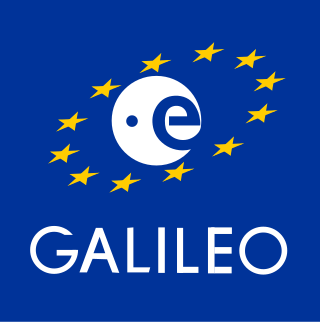
Galileo is a global navigation satellite system (GNSS) that went live in 2016, created by the European Union through the European Space Agency (ESA), operated by the European Union Agency for the Space Programme (EUSPA), headquartered in Prague, Czech Republic, with two ground operations centres in Fucino, Italy, and Oberpfaffenhofen, Germany. The €10 billion project is named after the Italian astronomer Galileo Galilei. One of the aims of Galileo is to provide an independent high-precision positioning system so European political and military authorities do not have to rely on the US GPS, or the Russian GLONASS systems, which could be disabled or degraded by their operators at any time. The use of basic (lower-precision) Galileo services is free and open to everyone. A fully encrypted higher-precision service is available for free to government-authorized users. Galileo is intended to provide horizontal and vertical position measurements within 1 m precision. Galileo is also to provide a new global search and rescue (SAR) function as part of the MEOSAR system.

Loran-C is a hyperbolic radio navigation system that allows a receiver to determine its position by listening to low frequency radio signals that are transmitted by fixed land-based radio beacons. Loran-C combined two different techniques to provide a signal that was both long-range and highly accurate, features that had been incompatible. Its disadvantage was the expense of the equipment needed to interpret the signals, which meant that Loran-C was used primarily by militaries after it was introduced in 1957.

A satellite navigation or satnav system is a system that uses satellites to provide autonomous geopositioning. A satellite navigation system with global coverage is termed global navigation satellite system (GNSS). As of 2023, Four global systems are operational: the United States' Global Positioning System (GPS), Russia's Global Navigation Satellite System (GLONASS), China's BeiDou Navigation Satellite System, and the European Union's Galileo.
The Research and Innovative Technology Administration (RITA) is a unit of the United States Department of Transportation (USDOT). It was created in 2005 to advance transportation science, technology, and analysis, as well as improve the coordination of transportation research within the department and throughout the transportation community.

Bradford Parkinson is an American engineer and inventor, retired United States Air Force Colonel and Emeritus Professor at Stanford University. He is best known as the lead architect, advocate and developer, with early contributions from Ivan Getting and Roger Easton, of the Air Force NAVSTAR program, better known as Global Positioning System.

The Quasi-Zenith Satellite System (QZSS), also known as Michibiki (みちびき), is a four-satellite regional time transfer system and a satellite-based augmentation system developed by the Japanese government to enhance the United States-operated Global Positioning System (GPS) in the Asia-Oceania regions, with a focus on Japan. The goal of QZSS is to provide highly precise and stable positioning services in the Asia-Oceania region, compatible with GPS. Four-satellite QZSS services were available on a trial basis as of 12 January 2018, and officially started on 1 November 2018. A satellite navigation system independent of GPS is planned for 2023 with seven satellites. In May 2023 it was announced that the system would expand to eleven satellites.

The Romanian Space Agency is a public institution with extra-budgetary funding that coordinates Romania's national space technology research programs and space research-related activities. ROSA was founded in 1991 and is subordinated to the Ministry of Education.
GPS sonobuoy or GPS intelligent buoy (GIB) are a type of inverted long-baseline (LBL) acoustic positioning devices where the transducers are installed on GPS-equipped sonobuoys that are either drifting or moored. GIBs may be used in conjunction with an active underwater device, or with a passive acoustic sound source. Typically the sound source or impact event is tracked or localized using a time of arrival (TOA) technique. Typically several GIBs are deployed over a given area of operation; with the total number determined by the size of the test area and the accuracy of the results desired. Different methods of GPS positioning may be used for positioning the array of GIBs, with accuracies of cm to meter level in realtime possible.

The Society for Marine Mammalogy was founded in 1981 and is the largest international association of marine mammal scientists in the world.
A software GNSS receiver is a Global Navigation Satellite System (GNSS) receiver that has been designed and implemented using software-defined radio.
Locata Corporation is a privately held technology company headquartered in Canberra, Australia, with a fully owned subsidiary in Las Vegas, Nevada. Locata has invented a local positioning system that can either replace or augment Global Positioning System (GPS) signals when they are blocked, jammed or unreliable. Government, commercial and other organizations use Locata to determine accurate positioning as a local backup to GPS.
The Southeastern Library Association (SELA) is an organization that collaborates with different library associations within the Southeastern United States, including Alabama, Arkansas, Florida, Georgia, Kentucky, Louisiana, Mississippi, North Carolina, South Carolina, Tennessee, Virginia, and West Virginia.
Inside GNSS (IG) is an international controlled circulation trade magazine and website owned by Gibbons Media and Research LLC. It covers space-based positioning, navigation and timing (PNT) technology for engineers, designers, and policy-makers of global navigation satellite systems (GNSS). In the United States, GNSS is identified mainly with the government-operated Navstar Global Positioning System (GPS). InsideGNSS.com is the complimentary website of online news, events, digital newsletters, and webinars, and archived magazine articles.
The Royal Institute of Navigation (RIN) is a learned society and a professional body for navigation. The RIN was founded in 1947 as a forum for mariners, pilots, engineers and academics to compare their experiences and exchange information. Today it is a leading centre for promoting knowledge in navigation and its associated sciences, including positioning, timing, tracking and conduct of a journey, whether on, in, over or under land, sea, air or space. The Institute has members in over 50 countries worldwide.
NextNav, Inc. is the developer of a 3D geolocation service known as Metropolitan Beacon System (MBS), a wide area location and timing technology designed to provide services in areas where GPS or other satellite location signals cannot be reliably received. MBS consumes significantly less power than GPS, and includes high-precision altitude. In the United States, NextNav operates its MBS network over its spectrum licenses in the 920-928 MHz band. The company went public on Nasdaq in October 2021 with a merger with special-purpose acquisition company Spartacus Acquisition Corporation.
Navigation is an open access academic journal about navigation published by the Institute of Navigation in cooperation with HighWire Press. Its editor-in-chief is Richard B. Langley; its 2021 impact factor is 2.1. The Journal Citation Reports categorizes the journal under aerospace engineering, remote sensing, and telecommunications.

James Julius Spilker Jr. was an American engineer and a consulting professor in the Aeronautics and Astronautics Department at Stanford University. He was one of the principal architects of the Global Positioning System (GPS). He was a co-founder of the space communications company Stanford Telecommunications, and was most recently executive chairman of AOSense Inc., Sunnyvale, CA.
Washington Yotto Ochieng is a Kenyan academic who is Head of the Department of Civil and Environmental Engineering at Imperial College London. Previously, he was Head of the Centre for Transport Studies and Co-Director of the Institute for Security Science and Technology(ISST) together with Deeph Chana. Ochieng is a Senior Security Science Fellow in ISST. He also serves as Director of the Engineering Geomatics Group and Chair of Positioning and Navigation Systems.
The United Kingdom Global Navigation Satellite System was a United Kingdom Space Agency (UKSA) research programme which, between May 2018 and September 2020, developed outline proposals for a United Kingdom (UK) owned and operated conventional satellite navigation system, as a British alternative to the European Union (EU) owned and operated Galileo Global Navigation Satellite System. The main reason was to provide a national and independent system, to ensure UK security following its withdrawal from the EU as a result of Brexit. It was fully supported by the Ministry of Defence.

Frank Stephen Tromp van Diggelen is a Distinguished Engineer at Google. His work concerns GPS/GNSS navigation. He helped to create some of the first GPS chips used in commercial smartphones. Van Diggelen is a fellow of the IEEE, Institute of Navigation and Royal Institute of Navigation.









